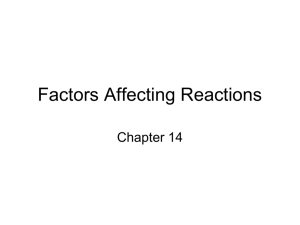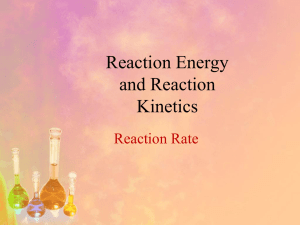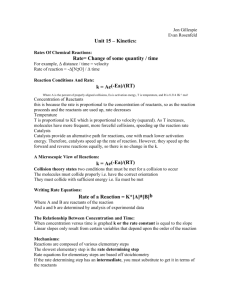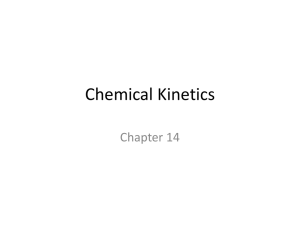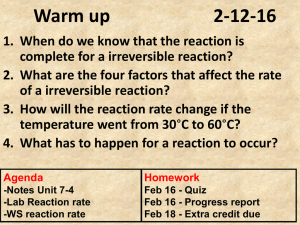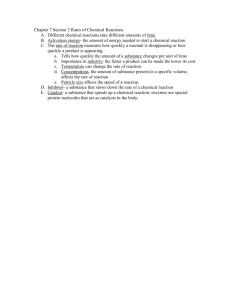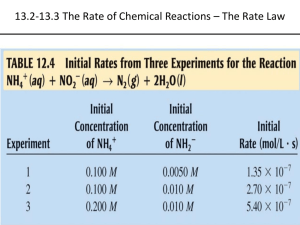Unit 13 Kinetics: Rates of Reactions
advertisement
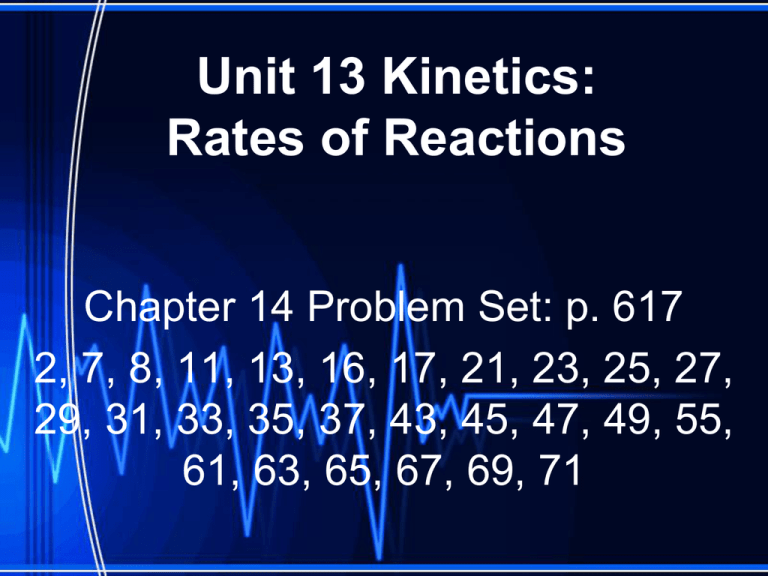
Unit 13 Kinetics: Rates of Reactions Chapter 14 Problem Set: p. 617 2, 7, 8, 11, 13, 16, 17, 21, 23, 25, 27, 29, 31, 33, 35, 37, 43, 45, 47, 49, 55, 61, 63, 65, 67, 69, 71 Rates of Reaction • Rate: Measures the speed of change that occurs within an interval of time • In chemistry we look at the amount of reactant changing per unit time • Change in concentration per unit time • For this reaction N2 + 3H2 → 2NH3 • As the reaction progresses the concentration H2 goes down C o n c e n t r a t i o n [H2] Time • As the reaction progresses the concentration N2 goes down 1/3 as fast C o n c e n t r a t i o n [N2] [H2] Time • As the reaction progresses the concentration NH3 goes up. C o n c e n t r a t i o n [N2] [H2] [NH3] Time Reaction Rate: the speed of a chemical reaction • Measured by the change in concentration of reactants or products per unit time • Units: M/s (molarity / second) • Average rate: average change in concentration of substance over time • Instantaneous Rate: The rate at any particular moment in the reaction • For the reaction aA + bB → cC + dD Orders of Reaction • Differentiated Rate Law (aka, rate law): Rate = k [A]x [B]y • k = rate constant – cannot be “calculated,” must be determined experimentally Rate = k[A] k[A]2 k[A][B] k[A][B]2 Order First Order Second Order Second Order Third Order Units for k Depend on the Order of the Rate Law • Units for rate are molarity/second, M/s, Ms-1 • Units for k will be whatever units make the rate law units work out to be M/s Writing the Rate Law From Initial Concentrations Example 1: NH4+ + NO2- → N2 + 2H2O 1. Write the rate law 2. Solve for k Experiment Initial [NH4+] Initial [NO2-] 1 2 3 0.100 M 0.100 M 0.200 M 0.0050 M 0.010 M 0.010 M Initial Rate of Formation of N2 1.35 x 10-7 2.70 x 10 -7 5.4 x 10-7 Example 2: S2O82- + 3I- → 2SO4 2- + I3A. Determine the rate law of the reaction above. B. Determine the value of k (with units) C. How is the rate of disappearance of S2O82related to the rate of disappearance of I- ? D. What is the rate of disappearance of I when [S2O82-] = 0.015 M and [I-] = 0.040 M? Experiment 1 Initial [S2O82-] Initial [I-] 0.018 M 0.036 M Initial Rate 2.6 x 10-6 2 3 4 0.027 M 0.036 M 0.050 M 3.9 x 10-6 7.8 x 10-6 1.4 x 10-5 0.036 M 0.054 M 0.072 M Integrated Rate Law: Try to figure out how to get a straight line on a graph! • First Order Reactions: Second Order Reactions: Zero Order Rate Law Integrated Rate Law: Try to figure out how to get a straight line on a graph! • First Order Reactions: Rate = k[A] ln[A] = -kt + ln[A0] y = mx + b k = slope of line t1/2 = 0.693/k t1/2 = half life • Second Order Reactions: Rate = k[A]2 1/[A] = kt + 1/[A0] t1/2 = 1/(k[A0]) • Zero Order Rate Law [A] = -kt + [A0] t1/2 = [A0]/2k Using the Integrated Rate Law • Example 3: For the gas-phase decomposition of nitrogen dioxide at 300 oC, NO2 → NO + ½ O2 , write the rate law and determine the value of the rate law constant. Time (s) 0.0 50.0 100.0 200.0 300.0 [NO2] (M) 0.01000 0.00787 0.00649 0.00481 0.00380 Example 4: a flask is charged with 0.100 mol of A and allowed to react to form B according to the hypothetical gas-phase reaction A (g) → B (g). Time (s) Moles of A 0.0 0.100 40 0.067 80 0.045 120 0.030 160 0.020 • Determine whether the reaction is first order or second order. • What is the value of the rate constant? • What is the half-life? Using Half-Lives with the Integrated Rate Law Example 5: The reaction of C4H9Cl with water is a firstorder reaction. C4H9Cl + H2O → C4H9OH + HCl From the graph, estimate the half-life for this reaction. Use the half life to calculate the rate constant. Concentration of butyl chloride as a function of time [butylchloride] (M) – – 0.120 0.100 0.080 0.060 0.040 0.020 0.000 0 200 400 600 Time (s) 800 1000 Half-Life, t1/2 – time required for the concentration of a reactant to drop to one half its initial value Example 6: The decomposition of a certain insecticide in water follows first order kinetics with a rate constant of 1.45 yr-1 at 12o C. • A quantity of this insecticide is washed into a lake on June 1, leading to a concentration of 5.0 x 10-7 g/cm3 . – What is the concentration of the insecticide on June 1 of the following year? – How long will it take for the concentration of the insecticide to drop to an EPAacceptable level of 3.0 x 10-7 g/cm3 ? Example #7: A certain first-order reaction is 23.0% complete in 42 seconds. Determine the rate constant and the half-life for this process. Example #8: A certain second-order reaction is 67.0% complete in 27.3 seconds. Determine the rate constant and the half-life for this process. Collision Theory • Given enough kinetic energy, atoms, molecules, and ions will react to form products when they collide • Lack of kinetic energy causes particles to bounce back without reacting • Collision theory states that in order for a chemical reaction to occur, the reactant atoms or molecules must collide with each other Effective Collision • When molecules approach one another, the valence electrons from one molecule repel the valence electrons in the other molecule and distort the existing bonds • If the reactant molecules collide with sufficient energy and in the correct orientation, the repulsion between valence electrons will break the existing bonds, allowing new (lower energy) bonds to form Ineffective Collision • if the reactant molecules do not collide with sufficient energy or collide in the wrong orientation, the existing bonds are not broken and no reaction occurs. Chemical kinetics: area of chemistry that is concerned with the speeds or rates of reactions Factors Impacting Reaction Rate: • Physical State of Reactants – the more that reactant molecules collide, the faster the rate of reaction • Concentration of Reactants – increase in concentration = additional collisions for collisions • Reaction Temperature – rate increases with higher temperature • Presence of a Catalyst – increase rate without being used up *provide an energy boost Temperature and Rate • Collision Model: molecules must collide in order to react – Molecules must collide with other “appropriate” molecules for the collision to be effective • Activation Energy: the energy required to initiate a chemical reaction (Ea) – There must be a specific amount of energy involved in order for collisions to occur Activation Energy • The minimum amount of energy that particles must have in order to react • A barrier that reactants must cross in order to convert into products. Activated Complex • Arrangement of atoms at the peak of the activation-energy barrier • Only exits for about 10-13 s • “New Reactants” • Also called the “Transition State” Activation Energy http://www.mhhe.com/physsci/chemistry/es sentialchemistry/flash/activa2.swf Addition of a Catalyst Arrhenius • Said that reaction rate should increase with temperature. • At higher temperature more molecules have the energy required to get over the barrier. • The number of collisions with the necessary energy increases exponentially. Arrhenius • Number of collisions with the required energy = ze-Ea/RT • • • • • z = total collisions e is Euler’s number (opposite of ln) Ea = activation energy R = ideal gas constant T is temperature in Kelvin Activatied complex: “prepared” molecules for a reaction • The fraction of molecules that have an energy equal or greater to Ea 8.314 • Arrhenuis Equation Frequency factor (constant for reaction) A = zp Calculating the Activation Energy for a Reaction • Rearrange the Arrhenius Equation • Utilize reaction data Warm-Up • Information for the chemical reaction was collected by measuring [A], at a particular temperature. Concentration versus time data were collected for this reaction and a plot of (1/[A]) versus time resulted in a straight line with a slope value of + 0.230622 M-1 sec-1. Calculate the time required for this reaction to be 84.6 % complete. Also, calculate the half-life time. Example of Using Arrhenius Calculate the activation energy (Ea) for the reaction N2O5(g) → 2NO2(g) + ½ O2(g) from the observed rate constants at the following two temperatures: (a) at 25oC, k = 3.46x10-5s-1 and (b) at 55oC, k = 1.5x10-3s-1. Reaction Mechanisms: A method that is used to show the intermediate processes that occur during a reaction • Lists the proposed changes that take place to the reactants as the product(s) is being formed. • Two or three chemical reactions, referred to as elementary reactions or elementary steps, shown one on top of the other. • Must follow the rate law to be considered valid • Must also follow the stoichiometry of the overall reaction Mechanisms and rates • There is an activation energy for each elementary step. • Activation energy determines k. • k = Ae- (Ea/RT) • k determines rate • Slowest step (rate determining) must have the highest activation energy. Example: nitrogen dioxide and carbon monoxide react by the balanced chemical equation: NO2 (g) + CO(g) → NO(g) + CO2 (g) Analysis of the reaction has detected the presence of the substance NO3 , which is neither a reactant nor a product of the reaction. One explanation for this finding is that the reaction proceeds in two steps: Step 1 ) NO2 + NO2 → NO3 + NO Step 2 ) NO3 + CO → NO2 + CO2 Sum of steps NO2 + NO2 + NO3 + CO → NO3 + NO + NO2 + CO2 Overall equation NO2 + CO → NO + CO2 Reaction Intermediate: Any substance that is neither a reactant nor a product but that exists during the reaction • In each elementary step, the number of molecules that take part in the reaction determines the molecularity of that step. • Molecularity is the number of pieces that must come together. • Unimolecular: single molecule is involved • Bimolecular: two molecules reacting • Termolecular: reactions involve three molecules (reacting) but are quite rare because they require the simultaneous collisions of three molecules. • • • • Example: Using the two elementary steps shown below, construct the balanced equation, and determine the molecularity of each step. NO2 + F2 → NOF2 + O NO2 + O → NO3 NOF2 + NO2 → NO2F + NOF NO3 + NOF → NO2F + NO2 Molecularity and Rate Law A A+A 2A A+B A+A+B 2A+B A+B+C products products products products products products products Rate = k[A] Rate= k[A]2 Rate= k[A]2 Rate= k[A][B] Rate= k[A]2[B] Rate= k[A]2[B] Rate= k[A][B][C] RATE-DETERMINING STEP: • In reaction mechanisms, the different elementary steps tend to occur at different rates. • The slowest step is known as the ratedetermining step for the reaction and will determine the overall rate at which the reaction will proceed. How to get rid of intermediates • Use the reactions that form them • If the reactions are fast and irreversible - the concentration of the intermediate is based on stoichiometry. • If it is formed by a reversible reaction set the rates equal to each other. Formed in reversible reactions • • • • • • • 2 NO + O2 2 NO2 Mechanism 2 NO N2O2 (fast) N2O2 + O2 2 NO2 (slow) rate = k2[N2O2][O2] k1[NO]2 = k-1[N2O2] rate = k2 (k1/ k-1)[NO]2[O2]=k[NO]2[O2] Formed in fast reactions • • • • • • • 2 IBr I2+ Br2 Mechanism IBr I + Br IBr + Br I + Br2 I+I I2 Rate = k[IBr][Br] but [Br]= [IBr] Rate = k[IBr][IBr] = k[IBr]2 (fast) (slow) (fast) The reaction between NO and H2 is believed to occur in the following three-step process. NO + NO → N2O2 (fast) N2O2+ H2 → N2O + H2O (slow) N2O + H2 → N2 + H2O (fast) (a) Write a balanced equation for the overall reaction. (b) Identify the intermediates in the reaction. Justify your answer. (c) From the mechanism represented above, a student correctly deduces that the rate law for the reaction is rate = k [NO]2 [H2]. The student then concludes that (1) the reaction is third-order and (2) the mechanism involves the simultaneous collision of two NO molecules and an H2 molecule. Are conclusions (1) and (2) correct? Explain. Catalysts • Speed up a reaction without being used up in the reaction. • Enzymes are biological catalysts. • Homogenous Catalysts are in the same phase as the reactants. • Heterogeneous Catalysts are in a different phase as the reactants. How Catalysts Work • Catalysts allow reactions to proceed by a different mechanism - a new pathway. • New pathway has a lower activation energy. • More molecules will have this activation energy. • Do not change E Heterogenous Catalysts H H • Hydrogen bonds to surface of metal. • Break H-H bonds H H Pt surface H H H H Heterogenous Catalysts H H H C C H H H H H Pt surface Heterogenous Catalysts • The double bond breaks and bonds to the catalyst. H H H C H C H H Pt surface H H Heterogenous Catalysts • The hydrogen atoms bond with the carbon H H H C H C H H Pt surface H H Heterogenous Catalysts H H H H C C H H H Pt surface H Homogenous Catalysts • Chlorofluorocarbons catalyze the decomposition of ozone. • Enzymes regulating the body processes. (Protein catalysts) Catalysts and rate • Catalysts will speed up a reaction but only to a certain point. • Past a certain point adding more reactants won’t change the rate. • Zero Order Catalysts and rate. R a t e • Rate increases until the active sites of catalyst are filled. • Then rate is independent of concentration Concentration of reactants Example (I) A2 + B2 ---> 2 AB (II) X2 + Y2 ---> 2 XY Two reactions are represented above. The potentialenergy diagram for reaction I is shown below. The potential energy of the reactants in reaction II is also indicated on the diagram. Reaction II is endothermic, and the activation energy of reaction I is greater than that of reaction II. a) Complete the potential-energy diagram for reaction II on the graph above. b) For reaction I, predict how each of the following is affected as the temperature is increased by 20°C. Explain the basis for each prediction. (i) Rate of reaction (ii) Heat of reaction
